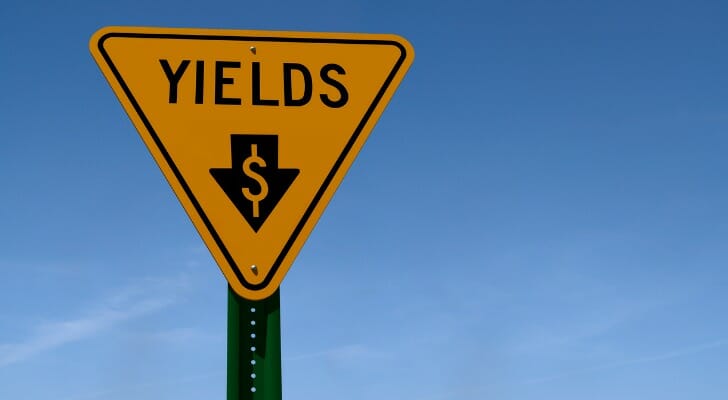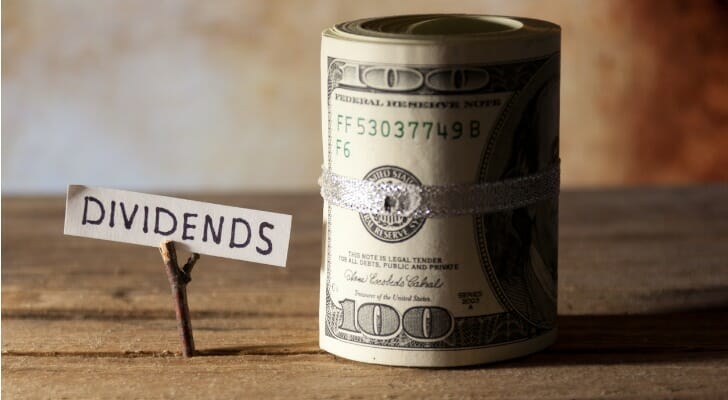Dividends are regular cash payments corporations make to shareholders to incentivize investment. The dividend yield is a percentage figure calculated by dividing the total annual dividend payments per share by the stock’s current share price. From 2% to 6% is considered a good dividend yield, but several factors can influence whether a higher or lower payout suggests a stock is a good investment.
A financial advisor can help you determine if a certain dividend-paying stock is worth considering.
Comparing Dividend Yields
One way to look at whether a dividend yield is a good one is to compare it to the dividend yield of the S&P 500. Many of these large blue-chip stocks pay dividends and their dividend yield is a useful benchmark for examining other companies’ dividend yields. As of this writing, the S&P dividend yield was approximately 1.25%. However, that is unusually low. The long-term average for the S&P 500 yield is currently 1.81%, which suggests that any stock paying more than 2% is worth a look.
Another way to evaluate dividend yield is to compare it to the yield on U.S. Treasuries. Investors seeking income frequently invest in both government bonds and dividend-paying stocks, so comparing these two assets is one way to reveal an attractive dividend yield. Also, U.S. Treasurys are paying up to 4.93%.
Finally, dividend yields can be compared among similar companies. Two companies of about the same size in the same industry will normally have similar dividend yields. If one is a lot higher, it may signify that it’s an attractive investment. However, high dividend yields can also be signs of trouble.
Causes of High Dividend Yields

A higher dividend is generally preferable to a lower one. And when a company is consistently raising its dividend in line with its profit increases, that can be a sign of a dividend yield that will reliably produce income. But sometimes a very high dividend yield can indicate that a stock is not a prudent investment. That’s because the dividend yield also depends on the share price.
If a company encounters challenging business conditions so that its stock price declines sharply while the dividend stays the same, the dividend yield may increase significantly. For example, consider a stock trading at $100 and paying $1 per share quarterly. Adding up the quarterly dividends to get a total of $4 and dividing that by the share price of $100 produces a dividend yield of 4%. If the company reports a decline in earnings so that the stock price declines to $50, the dividend yield doubles to 8%, much higher than most dividend yields.
But in this case the very high dividend yield may be a warning, not an indicator of a wise investment. Exceptionally high dividend yields may be unattractive because, in addition to dividends, the return on a stock investment includes capital appreciation. And total return, including dividends and capital appreciation, is highly sensitive to stock price.If the dividend yield is high because the company has fallen on hard times, it could signal further stock price decline. And if the stock declines even moderately, it can easily overcome the return-boosting effect of a high dividend, producing a negative total return for the investment.
Payout Ratio
Another way to evaluate the health of a company’s dividend is to look at the dividend payout ratio. This is calculated by dividing the quarterly dividend per share by quarterly earnings per share and expressing the result as a percentage.
For example, if a company earns $2 per share each quarter and pays out $1 per share each quarter, its payout ratio is $1 divided by $2 or 50%. If a company’s payout ratio is over 100%, that means it is paying out more than it is earning and may soon need to reduce the dividend. If profits decline and the dividend doesn’t, the company may need to borrow to keep the dividend up, which may not be sustainable in the long run.
Dividend yields above the 2% to 6% ideal range are not always a sign of impending trouble, however. Sometimes, dividend yields may be high because a company’s shares are undervalued. If research reveals the company’s fundamentals are strong, a higher-than-normal dividend yield can suggest the shares would be a good buy.
How to Use Dividend Yields to Build Your Portfolio
Dividend yield helps you decide how to balance income and growth. A steady 2% to 4% yield can provide regular cash flow, while growth stocks without dividends add long-term appreciation. Using both gives your portfolio stability and upside potential.
You can also compare yields across market sectors to spread risk. Utilities and consumer staples often pay higher dividends, while tech companies may pay little or nothing. Blending these types of stocks helps you capture income without relying too heavily on one industry.
Here’s an example. Suppose you have a $500,000 portfolio. If half is invested in dividend stocks with a 3% average yield, that portion generates $7,500 a year in income. If the other half is in growth stocks with no dividends, you still have the potential for long-term appreciation. If instead you invested the full $500,000 in stocks yielding 4%, you would receive $20,000 a year in dividends. Sounds good, but if you missed out on getting early investments in the next Amazon or Apple you’d be taking a huge loss in the future. The right mix depends on whether you want more income now or more growth later.
Reinvesting dividends adds another layer. During your working years, reinvested dividends buy more shares and compound returns. In retirement, those same dividends can shift into cash payouts, giving you income without selling investments. Dividend yield is not the only factor in building an investment portfolio, but it is a practical tool for shaping how your savings work for you.
Bottom Line

If you’re considering dividend investing, dividend yield can help you determine whether stocks are good alternatives to other income-generating investments and also suggest insights into a company’s financial situation. Many factors, including the overall market, interest rates, and the individual company’s financial situation, can influence dividend yields. However, usually from 2% to 6% is considered a good dividend yield.
Tips on Investing
- Accurately assessing a stock’s dividend yield and how it will fit in your financial plan calls for the assistance of an experienced financial advisor. Finding a financial advisor doesn’t have to be hard. SmartAsset’s free tool matches you with vetted financial advisors who serve your area, and you can have a free introductory call with your advisor matches to decide which one you feel is right for you. If you’re ready to find an advisor who can help you achieve your financial goals, get started now.
- Knowledge is half the battle. Make sure you know what taxes you may have to pay on your investments with SmartAsset’s free capital gains calculator.
Photo credit: ©iStock.com/MarkgrafAve, ©iStock.com/McKevin, ©iStock.com/Ridofranz
